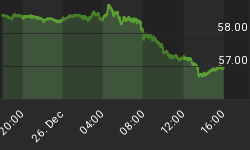Friday's payroll report was billed to be the main event that's supposed to determine the course of the financial market and perhaps our economy. With such a buildup, I was expecting the market to leap into high octane, high volume action with guns blazing. The outcome, nonetheless, was somehow anticlimactic. One thing I hoped to see in Friday's rally was money flow indicating that trouble with the financial sector was over.
Unfortunately, the intraday money flow - the difference between buy and sell dollar value - of the Financials dropped a whopping $187 million, or 85%, from noon hour to the closing (see check marks on Chart 1 below). Friday's closing figure was also 41% below Thursday's. This counter rally flow indicates the concern over financial sector's credit trouble may not be over yet. Money might've started rotating out of the sector. While it's great to see the S&P 500 Index (SPX) set new record, it's discouraging, and perhaps alarming, to see the financial sector's money flow disparity. Basic Materials intraday money flow also declined 11% or $8 million.

Chart 1
But money flow is not the only discontent. Friday's trading volume also indicates inadequate support from the market participants. Even though the SPX had set new record, the total trading volume was relatively light with just 2.29 billion shares changed hands. That's 430 million shares short of the 60-day EMA (red down arrow in the lower pane of Chart 2). The declining PVO (Percentage Volume Oscillator) shown in the upper pane of Chart 2 also illustrates this lack of volume support.

Chart 2
Judging from Technology's $126 million, or 61%, increase of the intraday money flow (revisit Chart 1 above), the market's more likely driven by the tech sector than the payroll report. At midday, the tech heavy Nasdaq represented over 63% of all 3 major exchanges' trading volume. This was a record since I started tracking this data in the beginning of July 2005. The surge in the tech sector was primarily fueled by the stellar earnings report of Research in Motion (RIMM). On Thursday, RIMM's volume almost doubled its 60-day EMA volume of 20 million shares. At 1:30 pm EDT on Friday, RIMM's volume had already surpassed 50 million shares while the Nasdaq 100 ETF (QQQQ) volume came in at just around 80 million shares.
However, even with the strong performance of RIMM, the Nasdaq 100 Index (NDX) displays similar lack of volume conviction. As much as it had skyrocketed almost 20% since mid August, the PVO of the NDX had been staying mostly under zero (see upper pane of Chart 3 below). The Volume by Price bars on the left also shows a declining Up Volume (light gray bars) since the NDX hit 2075. The price level of 2125-2150, achieved by the RIMM induced spike on Friday, is accompanied by the shortest Up Volume bar since the 1900-1925 price level.

Chart 3
But this lack volume conviction is not esoteric to just the 100 Index, the overall Nasdaq intraday market breadth performance (see Chart 4 below) had also been quite flat. This performance chart rebounded from the mid August bottom, and it proceeded to climb above both the 20-day (red line) and the 50-day (blue line) simple moving averages. However, since its 9/18/2007 peak, it has been staying flat and hovering around these 2 moving average lines. This tepid intraday breadth performance is contradicting the price uptrend.

Chart 4
Friday's RIMM led rally reminds me of the Apple (AAPL) led Nasdaq rally back in the first half of July. While the overall trading volume receded, everything still seemed honky dory till both the NYSE and the Nasdaq TRIN Index went below 0.70 on Thursday 7/11/2007. The next day. the TRIN Index dropped to as low as 0.39 and 0.43, respectively, while the Nasdaq's New High-New Low Index surged ahead to nearly 170 (non-cumulative). Then, the following week, Apple share price began to wobble, and the Nasdaq began its 12% month-long correction that shocked not only the Fed but also the financial communities all over the world.
On Friday, the big board's TRIN Index fell off the cliff to 0.53, and the Nasdaq TRIN dropped to 0.63. The Nasdaq's New High-New Low Index rose to a 4-month high of 173 (noncumulative). While we don't know whether we're going to see a re-run of July's correction, we know these are some of the signs showing that the market might've been overstretched or overbought. Another good technical indicator of an overbought market is the RSI. My RSI Overbought-Oversold Index had just crossed below the uptrend trendline on 10/3/2007 (see blue line on Chart 5 below). And, as much as the price had advanced on Friday, my scan of the overbought-declining RSI and the oversold-improving RSI had resulted in a 5-5 tie. This keeps my RSI index below the trendline. And it continues to pose as a threat to reversing the uptrend.

Chart 5
By all means, a bull market can stay overstretched for a while, but the current overstretched market with relatively low level of participation as well as persistent concern over the financial sector may have to start reversing to the mean sooner rather than later. We'll ride this uptrend for as long as possible but only with caution and protection.
















